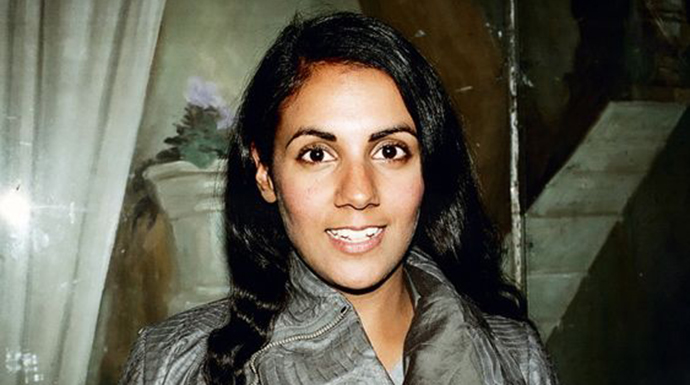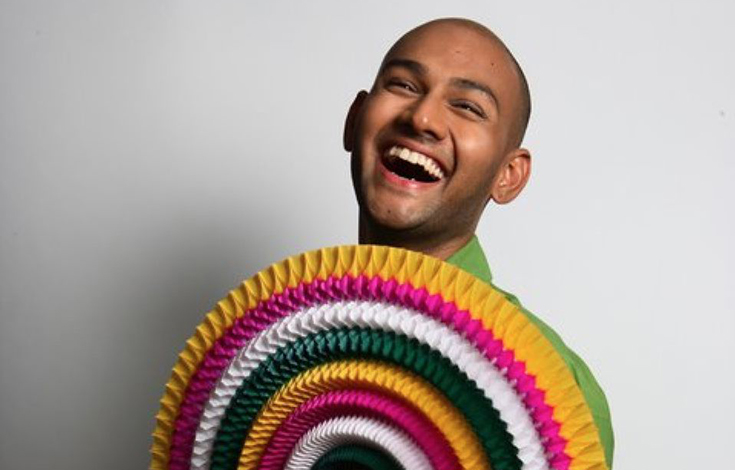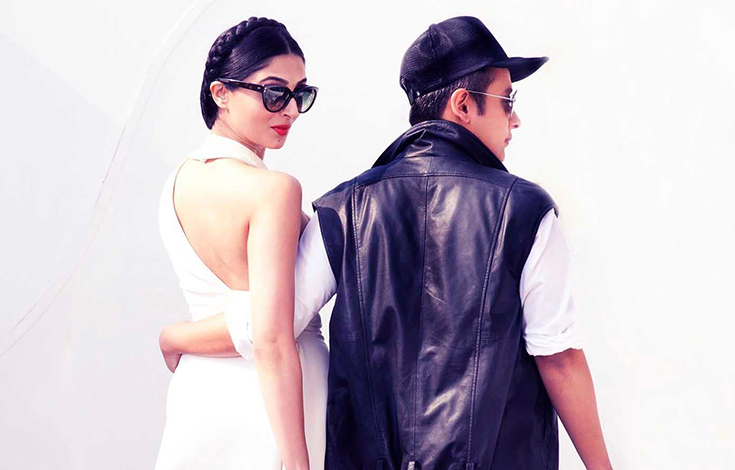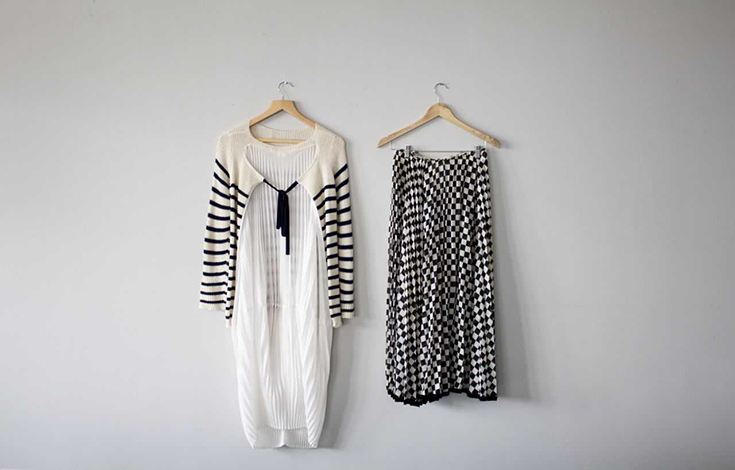Malika: You have had a very unique career path thus far – one would be hard pressed to find another stylist who has worked as extensively in the international industry and yet so close with the Indian one. I remember someone once commenting that you were able to create your Vogue India shoots due to being in a different context, perceiving India though a different lens. How true do you think this is?
Deep: I think it is very true. But I just do what I do!
In the beginning, my shoots with Vogue India were just an interpretation and a reaction to my own upbringing. They were very personal to me. It’s only now, after I’m no longer at Vogue, I hear people talking about a five-year-old shoot that I did and realize I’ve struck something. I’ve struck a chord with people who are in the same place as me, whether in India or England. I’m very self critical of my work. But I guess, in this space I’ll have to admit that this is something I understand.
India is a great source of inspiration. Observing people, culture – understanding the feelings I have when I am there and more than anything, hearing what people are saying.
I think I am a lot stronger for sitting in London because I have a different outlook on influences and understanding the business we’re in. In London, it’s easy to see the rest of the world and be objective, this is likely due to where London is geographically. In India, things become very city specific, so looking out to the rest of the world becomes difficult.
While I was still in University and working at Dazed and Confused, I realized a stylist is someone who gets to work with many diverse creative elements of fashion. It’s more ‘image making’ opposed to ‘styling’. Very early on, I actually fought India because I thought it was so obvious, myself being Indian, to use India as an inspiration. That’s something I now notice in other people – they’re trying to fight the one thing that is intrinsically quite natural to them. During my years assisting Nicola Formichetti, I saw how he used both of his cultures – he’s half Italian, half Japanese. It may not have been obvious to him, as that’s who he is, but it does influence his work. He’s now a phenomenon in Japan and much of the world. I believe his career has taken a very different path because of that fusion and he always used to tell me to embrace India and make it my own. Right before joining Vogue, I accepted that it is something I can do. I guess I first needed to explore the things that I could do without the stereotype of being Indian.
I’m proud to be Indian as much as I am to be British – you can have it all
I’ve been asked many times to move to India for work, but I say, “Do you actually want me to come sit in India to do that? Don’t you think the beauty of what you need is the fact that I’m not there?” Though at the right time and for the right opportunity, I would love to move to India.
Malika: Many people have said your absence from the pages of Vogue is felt. Do you think it will it always take a person outside of India to create such imagery?
Deep: That is very sweet of them to say. I’m not sure it’s geography; it’s more a point of view.
I think the talent in India needs be identified correctly and nurtured. More exposure, more time. For instance, in certain Indian magazines you see shoots that have been heavily ‘inspired’ by a shoot Vogue did. Regardless of whether you’ve seen the Vogue shoot or not, you can tell that something is being imitated, because it doesn’t resonate. Creative’s need to be inspired, come up with original ideas that are considered. In the same breath, it’s hard to be original these days. However you have to be intelligent and bring a newness to the table.
Ultimately, you are training your eye. This happens with intention, experience and exposure. I’ve been very fortunate to be surrounded by incredibly talented people from the very start, not only within fashion and photography, but also my friends and family, who aren’t creative’s in the context we are discussing, but very talented nonetheless. It’s fair to say my exposure has perhaps been greater than a lot of people in India, simply because the industry is so young there.
Some of the best images and artwork I admire are very simple and beautiful. They are the most difficult to do, as you have nowhere to hide. Many will think, “Oh, I could have done that”, a Pollock for example, “I could have splashed some paint around”. The thing is – “you didn’t and he did”. It looks easy, right? but one can’t imagine what thought processes went in to that, the one image may have taken a few days to create, but it takes years of experience and confidence in your vision – if only a silent one – to get to that point. That’s me, that’s my style. My style is always about the new and relevant version of something that already exists. I’m not doing anything exceptionally original. I’m just trying to make it relevant to today.
I become very passionate when it comes to India, because I have a great vision and hope for it. Staying true to India, being innovative and not imitating. It’s by bringing the best of everything together. How do we make the textiles/techniques from a small village relevant today? We need to find a new way of representing it all. The world admires and loves India creatively, that’s why so many designers outside of India are inspired by it. In terms of silhouette the West is pretty much all the same, whereas India has much more to offer. I agree India needs change in terms of aesthetics, but it can do that intelligently and confidently – being leaders at it.
Malika: How do you think we can educate the masses on the concept of styling and where do these aesthetics stand a chance given the rate at which international brands, who are Western apparel-focused, are taking over and pushing their vision? Do we stand to lose an opportunity to create a distinct contemporary Indian look that goes above that kurti and jeans combo?
Deep: We’re dealing with an industry that’s doesn’t have a right or wrong, it’s always an interpretation combined with social trends.
There is an intelligent way to reach the masses. People don’t know what they need, or what they want; people want to be told. At the same time, they’re not stupid.
Let’s not be ignorant to the fact that people don’t know how to wear clothes or put things together. The idea is to give people the confidence to be who they are, to be comfortable with what they are. Don’t try to always aspire to be someone else. That’s where the essence of my work comes from.
With India, it’s always going to be difficult because it’s a massive country and it’s got hundreds of different cultures within it. You’re never going to be able to get through to everyone. At the same time, I don’t want the whole of India looking the same.
The most inspiring people in India for me, are the people on the street. I derive a lot of inspiration from them, they don’t know that, but they are confidently getting on with it. Colors, styles, combinations… so in a sense, what am I teaching them? They’re teaching me something. I’m just presenting it back in a different way.
There is a small chance that you may miss the beat on creating a distinct contemporary Indian look, but it will take more than one generation to pass. But, I won’t let that happen! (laughs). Many great designers in India won’t let that happen. Those silhouettes have been around for centuries; they are not about to go anywhere. Look at Japan – they crossed generations beautifully.
Malika: India is very much in that moment of transition. There are things at stake. What are your thoughts on stylists who don’t know – and more importantly – don’t care to know how to tie a sari.
Deep: It becomes a responsibility. That’s how I see it. That’s why I sometimes become so passionate. I feel responsible. At Tatler, for example, I’m reaching out to 200,000 people, if they’re looking at my magazine for styles, what to wear this season it’s my responsibility to give them the best of that.
The only reason why you’re ‘good’ is because you’re relevant.
You’re reaching out to people, associating with their tastes and also leading them gently with you to develop their own style. In India, the sari is so intrinsic to everyday life. It may not be to you or those close to you, but our work goes beyond ourselves… most Indian women wear a sari everyday, I don’t know the facts – I just look outside. One should care!
Malika: Magazines tend to be an aspirational tool people look up to because of what is included. At the same time, by excluding certain things, you send a message. For example, magazines portray the sari largely as occasion wear. If we choose not to include saris as a work option, we are essentially saying that is not in the wardrobe of the aspirational Indian. Is this damaging? Is it the role of fashion media to own up to that responsibility?
Deep: Yes, totally! But you have to be in the position to direct the media/magazine in that direction. That takes foresight, confidence, belief and knowledge. If the decision makers point of view is, “Modern Indian women aren’t sari/salwaar kameez wearing” then that’s the direction the magazine is going to go. No matter what your views are, you can’t do anything about that. That’s where it becomes a social responsibility.
Personally, I feel it’s a huge shame if that was to happen. You might not wear the sari as your mum did, but it isn’t just for cocktails and weddings. This is why I did the ‘new wave’ story in Vogue, which showed new ways of wearing a sari. The editorial was extreme, but sometimes you have to be extreme to explain and inject a new thought. How many people actually challenge the notion of a sari blouse?
Malika: But who is going to say “Hey, we’re going to take a risk, we’re going do something conceptual. Perhaps our readers are ready for this.” What is it going to take to break away from celebrity cover, risk-averse editorials and how do those mindsets change when it always comes down to the bottom line?
Deep: I will! – (laughs). It happens with a group of people thinking alike. That already exists in India – and that’s why I think India is ready. The fact that we’re having this conversation means as much. Together we know other people that think exactly the way we do. I think it will take some strong individuals to do something. And it doesn’t take long to cause a ripple, it’s already happening.
I think what people need is choice. They need comparisons. At the moment, a handful of media dictate what’s going on, but when you have ten, you have a choice, you can join a different camp that suits your needs. That camp isn’t a battle against the another, it’s just a different point of view.
I knew that Vogue was going to be Bollywood driven, in terms of its covers. American Vogue only has celebrities on theirs, so it’s nothing new. But I believe it’s a cycle. Let’s hope that things will change again, that depends on social trends. What we do is a reaction to the time we live in!
Many people also miss the point, that the bottom line will look after itself if you do what you believe in and people connect to it. That balance is where you need to take a calculated risk.
Malika: I can’t tell you how many stylists who work within fashion media are on the same page as us. There are many voices that want to push the envelope. For some reason, everyone is happy to talk ‘off the record’ but the minute you want accountability, it’s a different story. Is this perhaps an issue of confidence and bureaucracy?
Deep: Absolutely. It’s a small world.
I ‘m a firm believer in good old hard work and good people.
If my work is perceived to be successful, it’s purely because of other people in my life. Yes, I might have had the intention and put in the hard work – but it’s about being given the opportunity. Recent examples: at Vogue India I wholeheartedly give the credit to Anna Harvey, who believed in me and employed me at the wonderful world of Condé Nast. My work with Tatler this year and the changes I made, the credit goes to my editor Kate Reardon, who allowed me to explore. If you don’t have those kind of values and people, then you’re not going very far.
Comparatively, in London you are valued for what you do and what you bring to the table a lot more. In India, the idea of a trusted, collective team seems like a very new notion. I can only assume this comes from insecurities and inabilities. It’s very positive to work in an environment that says, “well done, you’re amazing and thank you” and for criticism to be constructive. In the case of a magazine, every single person in the team brings their own expertise, skill and knowledge and needs to be valued and respected. It will change, as working environments evolve as the rest of the industry does.
Malika: Do you think that’s because it is a new industry, or is it the mindset? How can we change that?
Deep: It’s hard to answer that. But I think it’s by empowering people, not oppressing them. Loosen the reigns on people, trust their abilities. That’s how it works here. We’re all hired to be the best at what we are. I might not be right, but this might be generational. It will change in the next generation if we empower them. I have great belief and great hope that it will change.
Malika: I think another thing that helps is mentoring. What advice can you give aspiring stylists in India?
Deep: Understand different types of styling that exist: editorial and costume are very different. Fantastic costume (film) stylists have to understand the characters of that film as if they were them – how that character would move, stand and feel in a certain outfit. A fashion (editorial) stylist, also known as Fashion Directors and Fashion Editors, work with fashion right now, as it happens and interpret that for their relevant audience.
Understand the elements of image making – train your eye. It’s so much more than just clothes. It’s being aware of cultural shifts. Being aware of what’s going on in the world right in all areas; social, technological, arts, films etc. Stay open minded so you can adapt, things change and move quicker now than ever before.
My biggest piece of advice always includes “work hard.” Always! Get as much exposure as you can get, as much training, as much experience. It’s like painting; it’s like driving a car—the more you do it the better you get at it. It’s a very competitive industry here. We’re very fortunate to do what we do. We’re very fortunate to travel – but look at the hard work that goes into it. Have a vision, have a perspective, have a view and stick by it. Always see everything as an opportunity.
If you think of something and you believe in it, it’s not wrong, don’t be scared of voicing it.
The other thing is, very few people grow up thinking “I’ve still got so much more to learn”. So many people think that they know it all – that’s where you’re going to get stuck. That’s why I like engaging with the next generation and remind them to stay fresh, stay young, stay modern and stay relevant. Don’t always think that you know it all. But I do remember when I was about 20, I thought I knew it all!
Finally, I don’t like mediocrity. It’s a big problem in India, the “That will do/chalta hai” attitude. When I’m editing an image it can take me hours to choose one picture and in a heartbeat my editor might come back to me and say, “Well Deep, I like another one.” Most of the time you fight for the one you believe in, because you’ve invested so much in it and have seen the process from when it was a seed. Love and passion for what you do is why a single image can mean so much!
Malika: Who are other like-minded individuals that you respect, admire or connect with?
Deep: The likes of Grace Coddington. Grace has now become famous because of the September Issue movie, but if you are in the industry, you knew of her work a long time ago. She is a perfect example that mixes commercial viability with insane creativity. I’ve also just read her book, so she’s very much at the forefront of my mind. Looking back, Irving Penn was phenomenal, very quietly brilliant. Steve Jobs, such a great alternative, confident way of thinking and believed in beauty and simplicity of products. They’re amazing because at the time they did what they felt was right.
As well, Prabhudda Dasgupta. A fantastic photographer, he was so comfortable in his own skin, in his sense of purpose. It will always be sad that I never got to work with him. We always spoke of working together – is it because he thought I was the most fantastic stylist? No. It was like-mindedness, the same passion.
Rhea Kapoor, we often chat about the changes etc. that need to happen. She is buzzing with great ideas and is doing something about it. Arjun Bhasin, he makes me laugh so much. A great spirit to match a fantastic talent. A perfect example of someone who understands a character as if he was it. Ektaa Aggarwal of 369inc. First time I met Ektaa it was like we’d know each other for years, we totally get and respect each other’s aesthetic. Bandana Tewari, she has an incredible passion and wholeheartedly supports young Indian talent. A brilliant ambassador for India! Everyone, rightly so, loves her.
Malika: I love that you have so many examples of people you admire. Can you conclude by expressing what you think next steps for ‘Creative India’ are?
Deep: India has to believe in itself – know that it is truly ‘incredible”. Thankfully there are people doing something – many quietly, who may just need the right platform to shine. I too have big plans for it, I’ve talked a lot in this interview but it’s time to ‘do’.
My motto for India is: “We have to patiently act fast”
You have to be patient with it – but it has to happen soon. It will all be brilliant!
_________________
London based, Deep Kailey is currently the Fashion Director of Tatler. Previously she was Fashion Editor (London) at Vogue India, Contributing Fashion Editor at Dazed and Confused and Managing Director at Kim Jones.





This was a wonderful read. The questions were very well thought out. I’ve been bingeing on your articles!